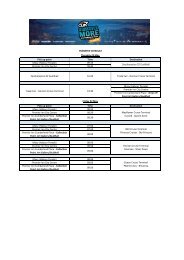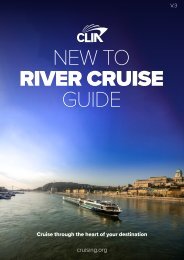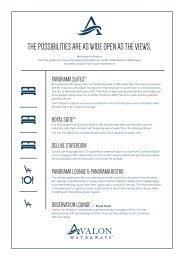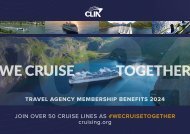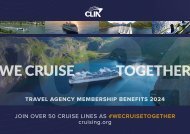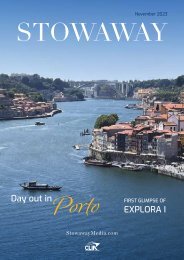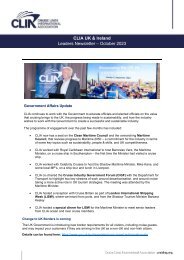Public Health Aboard - Prepation, Prevention and Response
Create successful ePaper yourself
Turn your PDF publications into a flip-book with our unique Google optimized e-Paper software.
PUBLIC HEALTH BOARD<br />
Preparation, <strong>Prevention</strong> <strong>and</strong> <strong>Response</strong><br />
Moderator:<br />
DR. KATE BUNYAN<br />
Medical Director<br />
CARNIVAL UK<br />
MARIA PITTORDIS<br />
Partner & Head of Marine Trade & Energy<br />
HILL DICKINSON LLP<br />
DR. PIERFRANCESCO LEPORE<br />
Fleet Medical Director, Corporate Medical Services<br />
MSC CRUISES<br />
MEL SKIPP<br />
<strong>Health</strong> Policy, Maritime Policy & Analysis<br />
CARNIVAL CORP &. PLC
DR. KATE BUNYAN<br />
Medical Director<br />
CARNIVAL UK
<strong>Public</strong> <strong>Health</strong><br />
The Everyday Reality
Is it Inevitable?<br />
• Maria Pittordis<br />
• Before, during <strong>and</strong> after cruise measures to reduce the risk<br />
• How to demonstrate the measures used <strong>and</strong> why it is so important<br />
• Mel Skipp<br />
• The role CLIA is playing helping the cruise industry to lead the world in management of illnesses like Norovirus<br />
• Dr Pierfrancesco Lepore<br />
• When it does happen, how is a typical cruise ship geared up to manage it?
MARIA PITTORDIS<br />
Partner & Head of Marine Trade & Energy<br />
HILL DICKINSON LLP
1. Recent Claim Trends<br />
• Explosion in the number of claims<br />
• Family or multi party actions to avoid small claims limits<br />
• Mixed with quality complaints<br />
• Not always for the same cruise or same illness<br />
• Illness not specified “infective viral or bacterial GI illness”<br />
• Always allege food <strong>and</strong> drink as a source coupled with alleged lack of hygiene<br />
• Always claim they did not eat off the ship<br />
• Claimant solicitors try to stop their medical experts answering Part 35.6 questions<br />
• Claimant solicitors seeking extensive <strong>and</strong> disproportionate disclosure<br />
• Explosion in number of claims management companies dealing with sickness claims
Why the increase in UK Claims?<br />
• CFA / ATE insurance in run off for pre 1 April 2013 cases<br />
• No win no fee <strong>and</strong> Qualified One way Costs Shifting<br />
• No portal for illness / accidents outside the UK<br />
• No fixed costs for Claimant legal costs<br />
• Significant cost recovery / lucrative cases for Claimant solicitors
Recent developments
Reminder - Legal Liabilities Arising From<br />
• Causing illness<br />
• Failure to identify illness / outbreak<br />
• Failure to have adequate procedures <strong>and</strong> or Outbreak Plan<br />
• Failing to implement procedures or Outbreak Plan adequately<br />
• Failing to comply with industry st<strong>and</strong>ards <strong>and</strong> relevant codes, Regulations etc.<br />
• Difference in liability between viral claims <strong>and</strong> bacterial claims
2. Recent developments<br />
• Wood v TUI 2017 S.4(3) Supply of Goods <strong>and</strong> Services Act 1982 <strong>and</strong> The Package<br />
Travel Regulations 1992 food was held to be goods of “unsatisfactory quality”!<br />
• Uniqueness of PLR / Athens Convention regime <strong>and</strong> Nolan v TUI 2015 judgment<br />
<strong>and</strong> differences with Swift v Fred Olsen 2016<br />
Relevance of Wood v TUI to cruise cases<br />
• Shore excursions<br />
• On board infection<br />
• Importance of distinguishing between food poisoning <strong>and</strong> Norovirus<br />
• Importance of r<strong>and</strong>om food testing<br />
• Importance of identifying the pathogen
Some Science
3. What can the epidemiological curve <strong>and</strong> a GI log tell you?<br />
Can provide information on<br />
• Pattern of spread<br />
• Magnitude<br />
• Inferences about the outbreak's mode of spread<br />
• Time trend<br />
• Exposure <strong>and</strong>/or disease incubation period<br />
• Whether single point of infection or person to person spread<br />
• Possibly source of infection<br />
• When it started <strong>and</strong> possibly from whom<br />
• Whether it was brought on to the vessel at embarkation or during the cruise<br />
• Whether illness was well controlled
Illness<br />
Bacterial<br />
/Viral<br />
Where you get it form Symptoms Incubation Period<br />
Salmonella, Bacterial Usually contaminated food Diarrhoea, stomach cramps, sometimes vomiting<br />
<strong>and</strong> fever<br />
Usually last for 4-7 days.<br />
12 to 72 hours<br />
E-Coli Bacterial Contaminated food, touching infected<br />
animals, person to person, swimming in<br />
contaminated water<br />
Campylobacter Bacterial Usually contaminated food (typically raw<br />
poultry can be found in unpasteurised milk<br />
or untreated water). Can be passed on from<br />
touching infected animals.<br />
Diarrhoea, stomach cramps <strong>and</strong> occasionally fever.<br />
About half of people with the infection will have<br />
bloody diarrhoea. Can last up to 2 weeks.<br />
Nausea, diarrhoea, vomiting., stomach cramps<br />
<strong>and</strong> fever. Diarrhoea can be bloody. In most<br />
people, symptoms are relatively mild <strong>and</strong> improve<br />
within 2-3 days<br />
Usually reported as 3 to 4<br />
days, but may be as short as 1<br />
day or as long as 10 days<br />
Can be as short as one day or<br />
as long as 11 days<br />
Cryptosporidium Parasite It passes out in the faeces of infected<br />
humans <strong>and</strong> animals. It can then be found<br />
in soil, water, food, or on surfaces that have<br />
been contaminated with the infected<br />
faeces.<br />
Watery diarrhoea with abdominal cramps,<br />
vomiting, high fever <strong>and</strong> loss of appetite.<br />
Symptoms usually last around 12 to 14 days but<br />
can sometimes last for as long as one month<br />
3 to 12 days<br />
Shigella Bacterial Contaminated food or faecal oral route,<br />
person to person.<br />
Diarrhoea, fever, <strong>and</strong> stomach cramps. Usually<br />
resolves in 5 to 7 days.<br />
1 to 2 days
Epidemiological Graph of background levels of viral illness
Epidemiological Graph based on day of illness of a well controlled<br />
Norovirus outbreak
Claims h<strong>and</strong>ling
4. Claims h<strong>and</strong>ling<br />
• Robust claims h<strong>and</strong>ling<br />
• Knowing when to settle <strong>and</strong> when to fight<br />
‣Consider GI log <strong>and</strong> epi curve what story does it tell?<br />
‣Quality of Implementation evidence re outbreak / GI procedures<br />
‣Obtaining <strong>and</strong> testing Claimant’s factual allegations<br />
‣Requiring contemporaneous evidence of illness when illness not reported on<br />
the ship<br />
‣Request lab test results <strong>and</strong> medical records from Claimant<br />
‣Questions to Claimant’s medical experts<br />
‣Resist Claimant applications for extensive <strong>and</strong> disproportionate disclosure<br />
‣Provide adequate protocol reply on time with key documents if defendable<br />
‣Settle before protocol reply is due if issues <strong>and</strong> avoid large settlements<br />
‣Keep legal costs to a minimum
Management of evidence for trial
5. Management of evidence for trial<br />
Documentary <strong>and</strong> witness evidence of:<br />
• Epi curve coupled with microbiologist expert evidence<br />
• Policies <strong>and</strong> procedures (Shipboard outbreak plan, medical manual, HACCP etc. )<br />
• Food testing <strong>and</strong> swab tests (Salmonella, Shigella, Staphylococcus Aureus,<br />
Enteropathogenic E-coli <strong>and</strong> Norovirus)<br />
• General evidence of implementation of policies <strong>and</strong> procedures<br />
• Ship’s Medical records including GI questionnaires, cabin confinement letters etc.<br />
• Outbreak response (Cabin Confinement for 48hrs, GI Discussion Meetings)<br />
• Training documents (syllabus <strong>and</strong> records of training)<br />
• Information to passengers (Booking information, pre-boarding questionnaire,<br />
pillow letters, outbreak letters)<br />
• Onboard spend accounts / gangway records
The Future?
The Future?<br />
• Small claims increase from £1000 to £5000 imminent?<br />
• Persuade the MOJ to include illness / accidents outside the UK with a value of £1000<br />
to £25,000 to qualify for the portal<br />
• Fixed costs ( consultation for multi-track claims up to £250 000) 6 January 2017<br />
• Persuade the MOJ to allow Defendants to recover costs in multi party actions not<br />
just cases of fundamentally fraudulent claims<br />
• Operational improvements?<br />
• Structural changes?<br />
• Education of passengers<br />
• Technology ? chemicals / copper?
MEL SKIPP<br />
Manager – <strong>Health</strong> Policy, Maritime Policy & Analysis<br />
CARNIVAL CORP. & PLC
CLIA GI Task Force<br />
The GI TF was created in 2014 with scope to:<br />
• Harmonize industry approach to prevention <strong>and</strong> control<br />
• Improve expertise in the cruise industry<br />
• Review <strong>and</strong> collaborate in research with industry partners<br />
• Help counter media <strong>and</strong> public perceptions - improve <strong>and</strong> align global<br />
communications:<br />
o Consistent industry wide messages<br />
o Work with global health authorities to align communications<br />
• Work to increase self reporting – education <strong>and</strong> messaging
Norovirus – The Key Challenge<br />
• Number 1 cause of viral gastroenteritis<br />
• Estimated 699 million cases a year<br />
• Affects 1 in 15 people in US annually<br />
• Small numbers (18 viral particles) may cause illness<br />
• Symptoms of vomiting & diarrhea<br />
• Survives on surfaces for long periods<br />
• Easily spread in aerosol <strong>and</strong> by contact<br />
• Hard to destroy
CLIA GI Task Force Progress<br />
• Actions agreed to align/improve prevention <strong>and</strong> control<br />
measures<br />
• Review of member procedures <strong>and</strong> model “Outbreak<br />
<strong>Prevention</strong> & Control Plan” (OPRP)<br />
• Technology Panels – Science panel evaluation of products<br />
• Workshop events<br />
• Research <strong>and</strong> support – vaccine development etc.<br />
• Communications Group – work to align<br />
• Carnival Corporation – st<strong>and</strong>ard corporate procedures
CLIA GI Task Force Progress<br />
Research & Evaluation of Products:<br />
• Collaboration with NoroCORE – Technology Workshops & testing to evaluate<br />
products<br />
• CLIA/Carnival Corporation/North Carolina State University (NCSU):<br />
o Test surface disinfectants, h<strong>and</strong> sanitizers <strong>and</strong> novel products<br />
o Direct testing on human norovirus <strong>and</strong> range of innovative methods<br />
o Looking for 4 log reduction in 5 minutes<br />
o Aim to develop a harmonized approach to product evaluation<br />
o Allow more confidence in efficacy
Testing Surface Disinfectants on Human<br />
Norovirus<br />
• Final results <strong>and</strong> conclusions to be shared with Task Force <strong>and</strong> published.<br />
• Overall take home messages:<br />
o Concentration <strong>and</strong> contact time are important<br />
o Surface cleanliness really matters for disinfection - organic load<br />
significantly reduces performance<br />
o Use of different cleaning methods needs evaluation<br />
• Started testing h<strong>and</strong> sanitizers now – preliminary results
Future Work – GI TF & Carnival Corporation<br />
• Develop guidance on ship design <strong>and</strong> construction st<strong>and</strong>ards<br />
• Work to change current real time outbreak internet posting by US<br />
health authorities<br />
• Review application of current prevention <strong>and</strong> control procedures –<br />
look for opportunities to improve <strong>and</strong> new innovations<br />
• Examine h<strong>and</strong> washing frequency <strong>and</strong> behaviours especially before<br />
eating<br />
• Continue research for example:<br />
o Test cleaning/disinfection methods<br />
o Evaluate residual surface products<br />
o Evaluate other novel technologies
Novel Technologies for Surface Disinfection<br />
• Residual products – claim continued effects<br />
• Nanotechnology – surface coatings to enhance cleaning or residual effect<br />
• Use of copper alloys, silver <strong>and</strong> other finishes
Novel Technologies for Surface Disinfection<br />
• Ultra Violet (UV) – Pulsed Xenon or Mercury<br />
• UV <strong>and</strong> hydroxyl radical technology<br />
• Hydrogen peroxide gas
Thanks for Listening
DR. PIERFRANCESCO LEPORE<br />
Fleet Medical Director, Corporate Medical Services<br />
MSC CRUISES
• Ships are «floating towns» with unique risk factors from a<br />
Medical <strong>and</strong> <strong>Public</strong> <strong>Health</strong> perspectives:<br />
• Specific microenvironment<br />
PUBLIC<br />
HEALTH<br />
ABOARD<br />
• Many nationalities<br />
• Different ports of call with own specific risk<br />
• Itineraries of different length<br />
• Shorex excursions
REGULATIONS
ON BOARD<br />
MEDICAL<br />
CENTRE
EQUIPMENT
EVIDENCE BASED APPROACH<br />
STANDARD<br />
OPERATING<br />
PROCEDURES
Placing automated external defibrillators (AEDs) in key locations, <strong>and</strong><br />
making sure employees are trained to use them, can make the<br />
difference between life <strong>and</strong> death<br />
AEDs<br />
IN PUBLIC AREAS
INFECTIOUS<br />
DISEASE
HELICOPTER MEDEVAC<br />
LIFEBOAT MEDEVAC<br />
MEDEVAC<br />
AT SEA
ITINERARIES
Time for Questions








